As one of the absolute highlights of my second trip to Patagonia, hiking the Torres del Paine Circuit was an incredible introduction to the fierce wilderness yet surreal beauty of the Chilean half of this region.
It was also a lot of fun camping in Torres del Paine, a park known for its stunning vistas of cobalt-blue glaciers and feeling half a world away from civilisation.
The Circuit, or “O” as it’s also known, is rapidly growing in popularity among seasoned hikers and first-timers alike, given it is one of the most rewarding hiking trails in Patagonia.
While trekking in Torres del Paine National Park (particularly if you hike solo and avoid paying for an unnecessarily – and costly – tour) might seem a daunting prospect, it really needn’t be.
This list of 14 essentials to know before you hike will make the experience far easier to plan and significantly more enjoyable when you get there.
You can also check out our newer (and more detailed!) complete guide to hiking the O Circuit in Torres del Paine
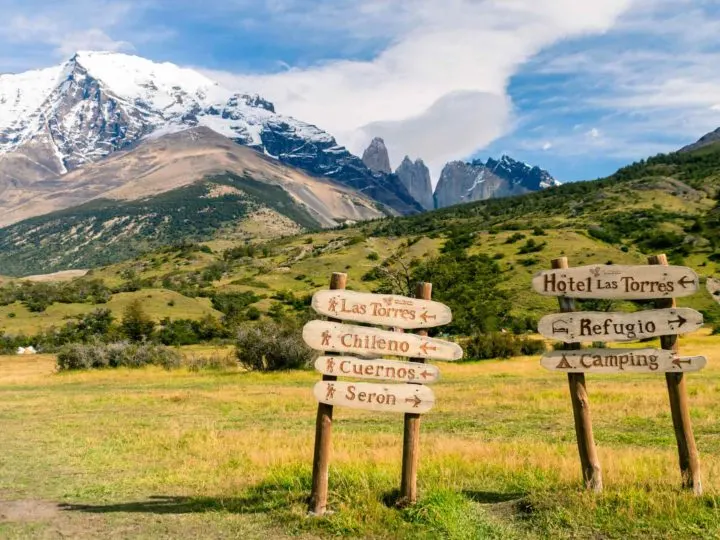
1. Hiking the O Circuit is no walk in the park
Ok, so before we begin, let me stress that the Circuit is a trek that should be taken seriously.
You cover a grand total of 76-miles over between nine and eleven days depending on the speed you choose and some days seeing you trekking over 11-miles – a distance that isn’t for the fainthearted.
Planning Your Trip to Patagonia?
Save time, stress & money with a customized travel itinerary planned for you by a Patagonia expert
You’re also camping, which can be a bit of a shock to the system for those who aren’t used to it.
While it’s an excellent introduction to multi-day trekking (more about that shortly!), you are carrying all of your equipment and your food.
The distance you cover each day won’t seem huge for those with hiking experience, it’ll be the weight of your rucksack that will leave you feeling less than perky by the prospect of continuing when you get today three.
Saying that…
2. It’s more challenging – but more rewarding – than hiking the W
As someone who has been hiking in Torres del Paine National Park on two occasions, once in March 2016 and again in March 2017, I can say with authority that the Circuit is definitely the more challenging hike and I would go as far as saying that it’s one of the most difficult hikes in Patagonia.
However, my experience of the W left me feeling a little short-changed.
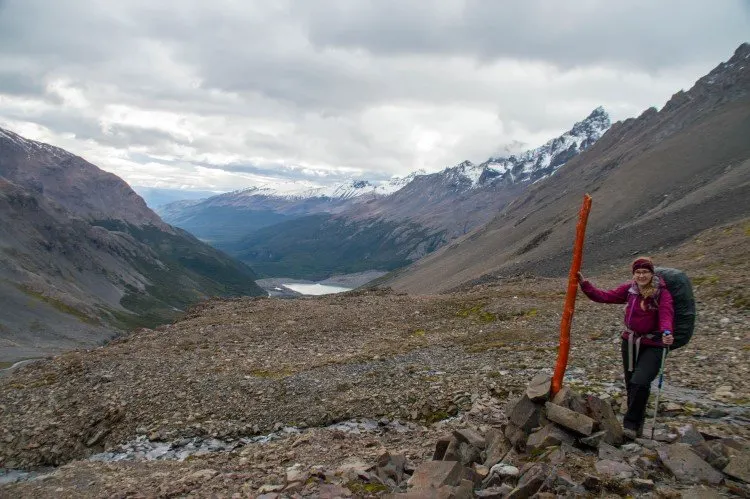
While I’ve written a length about how you can trek the W without a tour (and save yourself some pretty pennies in the process), this doesn’t fully solve my complaint with this particular trekking route around Torres del Paine National Park.
Unfortunately, as the popularity of the park has increased, so inevitably have visitor numbers and this has left the W, in particular, feeling more like a busy shopping centre on a Saturday morning than a tranquil, Patagonian paradise of unspoiled wilderness and silence.
While you can avoid at least some of the crowds in Torres del Paine National Park by visiting either in October/November or March/April (the shoulder seasons), the Circuit remains comparatively quiet throughout the months it is open, largely thanks to the limit imposed by the park’s management, CONAF, of 70 hikers per day.
As a result, at least during the opening stretches of hiking the Circuit, you’re unlikely to come across too many other walkers and camping in Torres del Paine at night is even more special as a result.
Add in the fact that you’ll be passing through what can only be described as sensational scenery and the challenge of hiking the Circuit in Torres del Paine is 100% worth it.
3. And you don’t need to be an experienced hiker
While it certainly helps to have at least a little trekking experience under your belt, hiking the Torres del Paine Circuit doesn’t require you to be a pro.
The biggest challenge that you’ll face is to ensure that your rucksack isn’t unrealistically heavy to the point that you can’t carry it (again, more on this shortly) and that you have the will-power to get up every day and continue hiking.
Sure, the landscape and the travellers you meant does make this significantly easier, but it ultimately comes down to your mental strength and your desire to succeed that will decide whether you do or not.
4. Having the right equipment makes all the difference
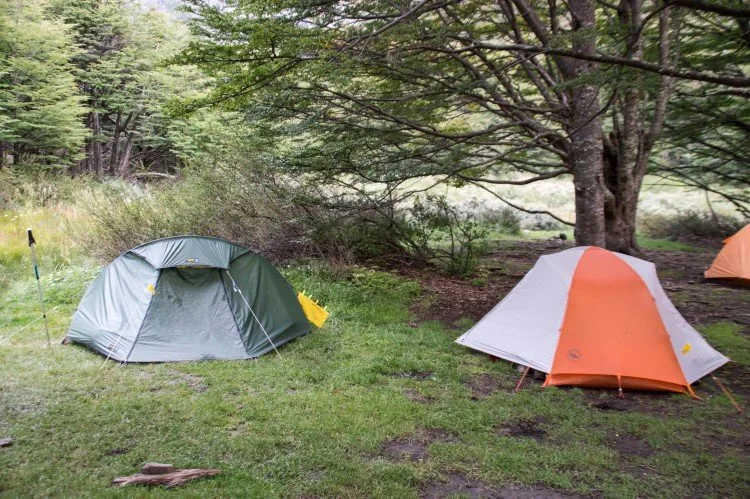
There is one simple way of making the Circuit trek significantly easier: planning the contents of your rucksack carefully.
In our case, it helps that my dad is a complete gear nerd and is already obsessed with lightweight hiking, but you too can easily ensure that you’re not overpacking and that your equipment is suited to the conditions of long-distance camping and hiking in Torres del Paine National Park.
I’ve written about this topic at length in this post about packing the correct equipment for hiking the Circuit, but what I will advise in shorter form is that a lightweight backpacking tent (such as the beautiful Big Agnes HVUL2 that we used – and I reviewed) alongside a lightweight sleeping bag and mat do make the difference between a 20kg rucksack and a far lighter, more manageable bag.
If you plan on renting your camping gear for Torres del Paine (something I’ve covered in this post about trekking the Circuit), it’s essential that you check your equipment thoroughly.
Rental gear faces a lot more wear and tear than personal equipment and discovering, half way around the trail, that the tent you hired has a huge hole in the outside layer through which the rain can enter is not anyone’s idea of fun.
I would strongly recommend you kill two birds with one stone and check out Big Agnes (she’s both incredibly lightweight and won’t let the rain in).
However, if you don’t plan on investing in a brand new tent, then make sure you test run outside of the shop any equipment you plan on hiring to confirm it’s in good condition before you pay.
5. Good quality, broken in and waterproof hiking boots are your #1 essential item
But good equipment isn’t just about your camping gear. I can’t stress this enough: carrying yourself and the weight of your rucksack over 76-miles is enough to leave your feet feeling seriously sore, particularly if you’re wearing poor-quality hiking boots and, like me, are prone to suffering the worst hiking ailment of them all: blisters.
Blisters were my Achilles heel for the first 25 years of my life due to poor fitting trekking boots and a lack of understanding that I really did need to wear two pairs of socks (one thick, one thin) to stop my poor little tootsies from being rubbed raw.
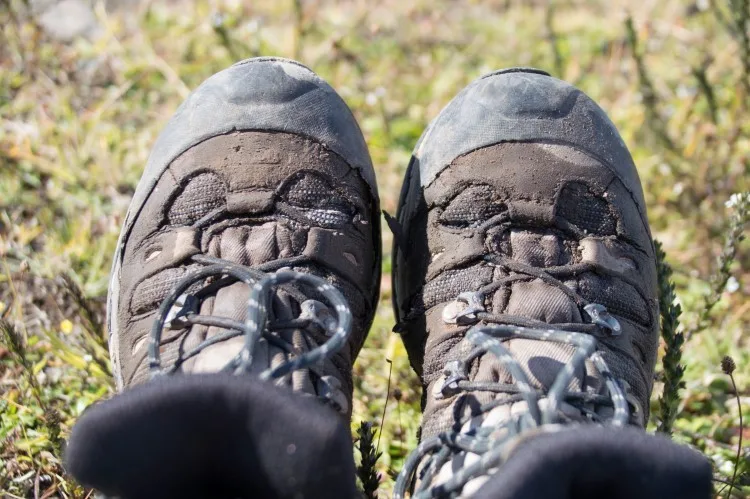
From this unpleasant experience, it is essential that if you plan on trekking in Torres del Paine National Park (or anywhere else in Patagonia for that matter) you must – must – buy good quality hiking boots.
I recommend high-ankle types such as my beloved Salomon Women’s Quest Prime GTX Hiking Boots (you can also find them on Backcountry|Amazon and the men’s version on REI|Backcountry|Amazon).
It’s also essential that you have broken in. What does this mean? This means you’ve worn them on at least a handful of previous walks and know that they don’t leave you bleeding and blistered.
My second big recommendation is that if you’re prone to suffering blisters (or not sure whether your hiking boots are the perfect fit) is that you buy some blister plasters before arriving in Patagonia (such as my favourites, Compeed) or head to a pharmacy in Puerto Natales to buy some there.
You can try to eliminate the prospect of blisters by applying the plasters to rubbable areas before you begin trekking the Circuit; they’ll act as a handy little barrier between your feet and the boot and can stop blisters before they form.
Ensuring that you boots are waterproof is another essential step on the path to having happy feet during the experience. I recommend you treat them regularly with a waterproofing spray (Nikwax do an excellent fabric spray that’s ideal for GORE-TEX fabric boots).
Finally, a set of trekking poles (you can also find them on Backcountry|Amazon) are also invaluable as they can help take some of the pressure off your hips and feet and are great for sections such as the dreaded descent from Paso John Gardner, which is exceptionally steep and slippery.
6. Clean socks are your friends
When I hiked the Circuit, I found to my despair that I hadn’t brought enough clean socks. Part of the problem was that I washed my socks mid-way through the hike and the weather wasn’t sunny enough to dry them, meaning that I had slightly damp pairs to put on each morning.
This was made worse by the fact that my beloved shoes, after two and a half years of extensive use, had finally ripped at the seams and were letting in water.
So, while wearing waterproof boots should stave off most of these issues, having a couple of extra pairs of socks so that you at least have something dry to wear each morning will make you feel a whole lot better about facing the challenges of the day.
I would also recommend a pair of Teva sandals or similar in case you need to ford rivers (something relatively unusual but that we did face after a lot of rainfall when we were hiking in Torres del Paine National Park).
I had some flip flops which were utterly useless because they almost were sucked away by the current, whereas sandals are far better at staying on your feet.
They’re also good for the evenings as you can wear them with socks to give your feet some time away from your boots and keep them warm at the same time (trying to do this in flip flops is not easy!).
7. Bring hot and cold weather clothing to hike the Circuit
One of the strangest things about Torres del Paine National Park and parts of Patagonia in general is the weather. It’s notoriously unpredictable, can pass from snowstorm to burning sunshine in the space of 15-minutes and in the summer, the winds can reach over 70 mph.
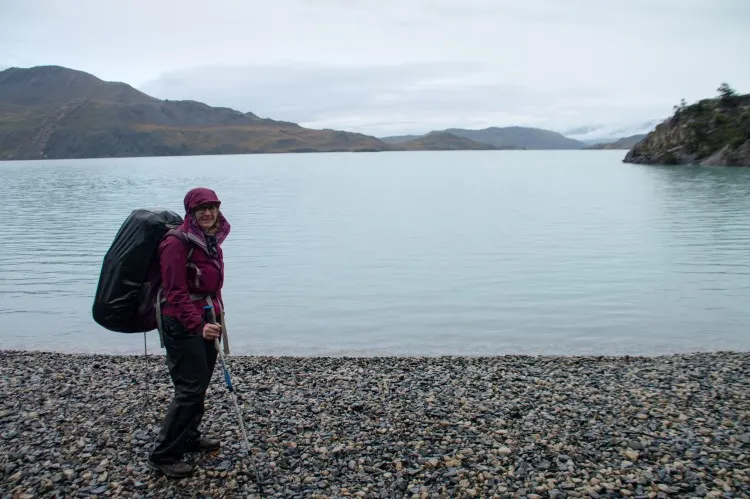
For this reason, packing for hiking the Torres del Paine Circuit requires a bit of thought, as you’ll need clothing that covers practically all seasons.
Again, I would recommend you check out exactly what I took in my rucksack when I experienced the Circuit earlier this year, but as a quick guide, your wardrobe should consist of thin layers that can be put on or taken off to adapt to changing temperatures as well as waterproof, windproof clothing.
I actually bought a pair of waterproof trousers in Puerto Natales last minute because it was pissing it down with rain the day before we started, and they also turned out to be an excellent investment against the rain, wind, cold and mud.
A waterproof rucksack cover is also a good addition, although if it’s ill-fitting or not attached to the bag then there’s a chance it will blow away.
Finally, an inner dry bag (such as these Sea to Summit dry bags on REI|Backcountry|Amazon) will avoid the possibility of you pitching up for the night and realising that you have no dry clothes to sleep in because the rain seeped into your rucksack.
While bin bags are a cheap alternative, bear in mind that they can easily rip, leaving them completely useless.
8. You have to be organised and book all camping spots in Torres del Paine in advance
Long gone are the days when you could just rock up into Torres del Paine National Park and starting hiking the Circuit; now you must book your accommodation online before you attempt the hike.
This applies to camping in Torres del Paine: both the campsites and lodges run by Vertice Patagonia and Las Torres and the free campgrounds run by CONAF (the ones at Paso, Italiano and Torres).
By the start of September in the 2019-2020 hiking season, the Circuit was booked up from the end of December through to mid-February, meaning that if you were planning on hitting the trail between those months and hadn’t already made reservations, it wasn’t going to happen.
My main piece of advice is to try and book your camping reservations as soon as possible. Outside the months of December through to February, there is less demand but I would still recommend booking early to avoid disappointment.
Even if the website says that the booking isn’t yet open, you can contact Vertice Patagonia and Las Torres via email to request your spot. They speak good English too. Reservations are now open for the 2023/24 season.
To book camping in Torres del Paine, use the following websites:
Alternatively, a faster option is to use Torres Hike, a website that allows you to book campgrounds for all three companies in one place. I’ve tried it for clients and it considerably speeds up the process.
Better still, read my comprehensive guide to booking camping and other accommodation in Torres del Paine and if you’re struggling, read about the six alternatives if you can’t make reservations in the park.
9. You MUST print out your reservations
I’m not going to relive the argument I had with the ranger at Los Perros because I had failed to print off my reservation for the next night’s stay at Paso.
Instead, what I will say is that you really must have copies of your camping reservations to show to the rangers.
Of course CONAF doesn’t have a list of who should or should not be camping at their site that evening; they are expecting you to arrive with the correct paperwork. If you don’t, there is a serious chance that you may not have a space to pitch your tent.
And while I never did find out exactly what I would be expected to do if I couldn’t camp overnight at Paso (were they planning on airlifting me out of the park?), the argument as you try and claim that you did indeed book, just forgot to print the reservation off, isn’t worth it!
10. You can charge electrical items in certain campsites
I was really surprised to discover that there were charging points in a number of the camping sites in Torres del Paine. We found this to be the case in Los Perros, the free CONAF campsite, as well as in the kitchens and indoors spaces in Paine Grande and Los Cuernos.
Seron, Dickson, Paso and Torres do not have plug sockets, but I suspect that Grey, Frances and Las Torres do.
So if you don’t have a battery pack (which you should, they’re a great item to bring for any trip to Patagonia so check them out on REI|Amazon), make sure you pack your charger.
11. Plan your food carefully
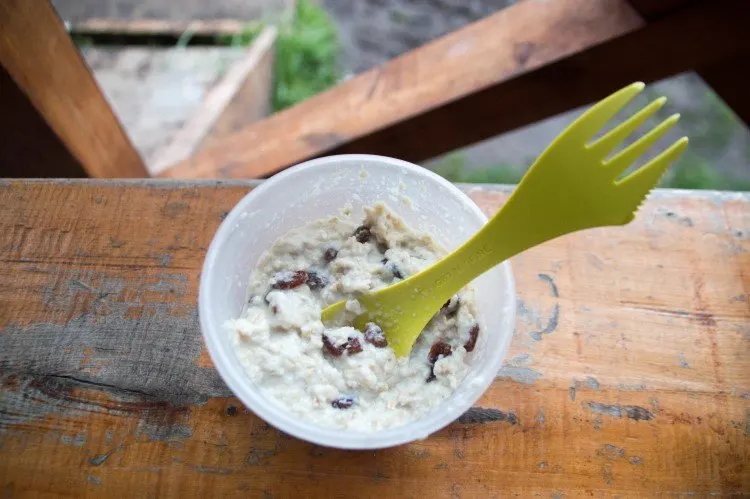
It’s very easy to overpack the food that you take with you into Torres del Paine and I put together this overview of exactly every item of food that we used for the Circuit to help you plan.
However, the main considerations are to ensure that you’ve got enough carbohydrates to keep you going (porridge oats, pasta, rice etc.) and that you only pack what you need.
Rather than take a 1kg bag of rice that you probably won’t use all of, pack it into individual portions in small, ziplock plastic bags.
This way, you’ve got everything at hand for cooking up your dinner quickly and easily, and by removing things from their original packaging, you’re reducing the weight you carry.
A secondary bonus is that this also helps to keep the park clean, as you’re expected to take your rubbish from most of the camping sites along the Circuit.
12. Bring a basic first aid kit
It’s never a great idea to go hiking without at least some basic first aid equipment.
My kit always including plasters, painkillers, a small pair of scissors, allergy tablets and bandages (check them out on REI| Amazon or you can easily put one together yourself).
But if you’re hiking the Torres del Paine Circuit, I would also recommend bringing strapping or a bandage for sprains – something that unfortunately happens quite regularly on the trail.
I’ve heard of a lot of people twisting an ankle or another part of their leg, which can be made even more painful by the fact that there are no medical supplies available in the refuges.
To be extra prepared, bring hiking poles so that if you do suffer a sprain, they can be used to take the weight off the injured limb.
13. Don’t forget the mosquitoes – or the sunshine
Torres del Paine National Park is probably the last place you’d expect to find mosquitoes, but in March when we were there, we were absolutely ravaged by these insects.
I’d not thought to pack any repellent, but lucky others had, which saved me from spending the nine-days itching at the bites.
Another important tip is to pack some high-strength sunscreen, and remember to keep reapplying as you sweat it off.
14. Want to hike in more comfort? Check out these “short cuts”
If you’re a bit concerned about the amount of equipment, food or distance you’re required to cover by trekking the Circuit, it’s worth considering these short cuts:
Actual short cuts to the route
Although the Circuit route is a standard distance, there are a handful of ways that you can shorten it. For example, on day one when you leave the bus at Laguna Amarga Ranger Station to begin the trek, there is a path that breaks away from the main road long before you get to Las Torres Hotel, and which shaves off a couple of miles.
This route isn’t marked on the map that they give you at the entrance and the signposts to it have been removed, but if you download the free app Maps.Me (one of my favourite apps for hiking in South America) you’ll find it clearly marked.
Another short cut is not hiking to the Britanico Lookout on day five and instead only reaching as far as the Frances Lookout. While I’ve heard that the Britanico Lookout is absolutely stunning, the day we arrived the weather was so poor that it made no sense to go that far.
Be a little bit flexible in your plans because the weather might well stop you from hiking here.
Camping in Torres del Paine “short cuts”
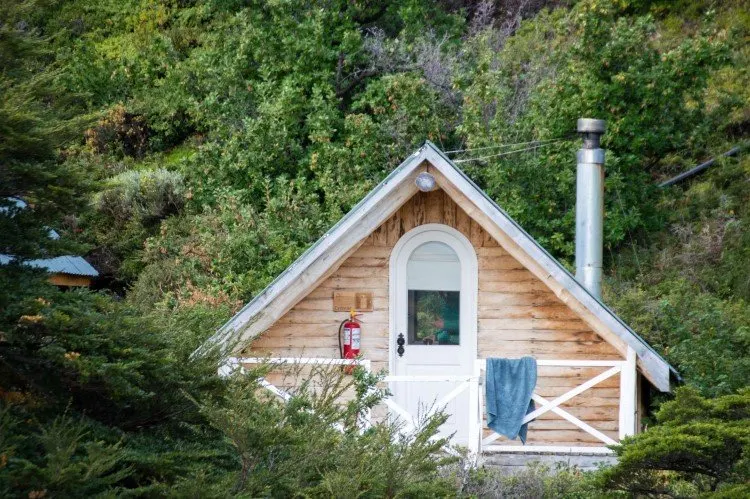
We weren’t 100% sure that we could physically carry all the food that we needed, despite the fact that we had planned our meals very carefully.
Because of this, we decided to shell out on an overnight stay at Los Cuernos Lodge on the night of day five, where we were fed a three-course meal and had access to a warm bar and hot showers.
Yes, it was expensive, but it was a well-earned treat after days of being cold and having to cook over our little stove.
This is an option that you can take at Grey Lodge, Paine Grande Lodge, Los Cuernos Lodges, Las Torres Lodge and Chileno Lodge and it’s worth considering it as a treat for all your hard effort of getting so far.

Mike
Tuesday 9th of January 2024
Thanks for the thorough post. I've read a bunch and I had no idea that the bugs would be a problem. You saved me from days of itching.
Steph Dyson
Sunday 14th of January 2024
No problem Mike!
Sandra
Friday 20th of October 2023
Hiya, I really enjoy your posts, have read probably all of them concerning TDP as we have been planning our trip this November. The only thing I can’t seem to find an answer to anywhere, do you have a recommendation on what to do with the rest of our luggage while we are hiking? Are there lockers at the Welcome Centre, or is it better to leave the luggage at Puerto Natales? Thanks in advance! Sandra
Steph Dyson
Thursday 23rd of November 2023
Hi Sandra, pretty much all accommodations in Puerto Natales will let you store you stuff with them while you're hiking. Steph
Karen
Tuesday 6th of September 2022
Hi Steph,
I enjoyed your article and am interested in TorresHike. What is your experience in providing a Passport Number in using this company? Are you still using them? Thank you.
Steph Dyson
Thursday 15th of September 2022
Hi Karen, the passport number is for so that they can buy your entry ticket for the park, for which you need to show your passport. Yes, I am still using them and they're the best way to make reservations for the park. Steph
Mikey
Saturday 23rd of May 2020
Hello! Thanks very much for your guide, probably my favorite of the many I came across while researching my trip.
I really want to know if I’m in Calafate and I want to go with my family but like in a trip of just going into the park for 1 day can I? what would you recommend?
Thanks. It’s very useful information.
Steph Dyson
Friday 12th of June 2020
Hi Mikey, there are tour operators that organise 15-hour tours from El Calafate to Torres del Paine for the day or you could drive yourself if you have a vehicle. Torres del Paine is beautiful, but it's a 3.5-hour minimum drive each way to the park, plus time at the border for passport control (which can take a long time if you're there between December-February when there are loads of buses crossing the border), so I think the question really is if you want to spend at least seven hours in your car for a day trip to the park. Hope that helps, Steph
Anna
Wednesday 13th of November 2019
This is a super helpful article! We love all of your tips and guides on trekking Patagonia. We are planning to do the O trek as part of our backpacking south america. I had one question for you-- do you know of any lockers or places to store belongings that we are bringing to south america, but don't necessarily want to pack with us on our Patagonia trek? Thank you again!
Steph Dyson
Thursday 21st of November 2019
Hi Anna, you can leave a bag of belongings in your accommodation in Puerto Natales. Refugio Torre Central also stores backpacks for $4-$8 USD per day, depending on their size. Steph